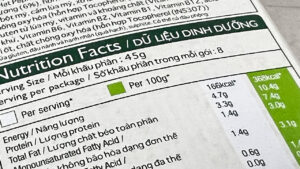Knowing what you eat: How to read nutrition labels

GERARD WONG, Senior Dietitian at Singapore’s Parkway Cancer Centre, gave a talk in Makati on June 21 where he discussed the ways the fine print on food can fool us, leading us a pivotal step away from eating (and living) healthily.
For example, he points out the different conventions by which food is labeled in the US (and consequently, in a country which it influences, the Philippines) and in the UK (in turn influencing Singapore). In the UK, serving sizes and their corresponding nutritional values are parsed out per 100 grams. In the US, and other countries following their conventions, it’s a little bit murky.
Visiting a supermarket prior to his talk, he came upon a package of local hotdogs. Asking the audience how much they would eat out of a package of eight, some of them answered two. Reading the fine print, one learns that the suggested serving size is a quarter of each hotdog. “Who eats one quarter?” Mr. Wong asked. “The amount per serving is not a good indicator, because everyone is different.”
With a quarter of a hotdog rounding out at about 70 calories, that would mean that a whole dog would amount to 280 calories, and the usual serving size in a household of two per person means that two hotdogs at breakfast would mean consuming 560 calories — a quarter of the recommended calorie intake, at about 2000 calories per day. That would exclude all the trimmings one eats at breakfast.
A pack of cookies he picked up, meanwhile, illustrated the next point. Ingredients are listed by their amount in descending order, meaning the first ingredient is the most prominent in the product, followed by those in decreasing amounts. From the pack of cookies, one expects the first ingredient to be listed as flour, but in this case, sugar took the top spot. “If you’re not reading the label, I wouldn’t [know they] make a cookie with more sugar than flour,” he said.
Potato chips and biscuits were next on the block, where he found out that they were made with hydrogenated coconut oil and palm oil, which is not good for one’s cholesterol levels, since they contain saturated fat. These contribute to high levels of triglycerides and low-density lipoprotein (LDL), which stay around and clog blood vessels. He also warned about the label “vegetable oil,” which can mean anything (including the aforementioned oils). He recommends seeking out food that uses sunflower, canola, olive, peanut, or rice bran oil. In addition, he said that in reading food labels, one should seek food labeled with a total fat content of lower than 10 grams per 100 grams, a sodium content of less than 120 milligrams per 100 grams, and a fiber content of more than six grams per 100 grams. This is because fiber, in its role of aiding digestion and promoting gut health, makes sure that carcinogenic compounds leave the body faster before they can do any real damage (such as colon cancer).
This is important because according to him, there’s a strong link between being overweight or obese and cancer risks. He adds, “As a country modernizes, there’s an increased prevalence of incidences of cancer,” he said, pointing to Myanmar’s profile, which saw a shift in the diseases of its population from those related to malnutrition to diseases caused by “chronic overnutrition,” including diabetes and obesity, after its industrialization.
“Labeling has to be true to the word, by law,” he said. “You need to have an idea of what you need.” — Joseph L. Garcia




